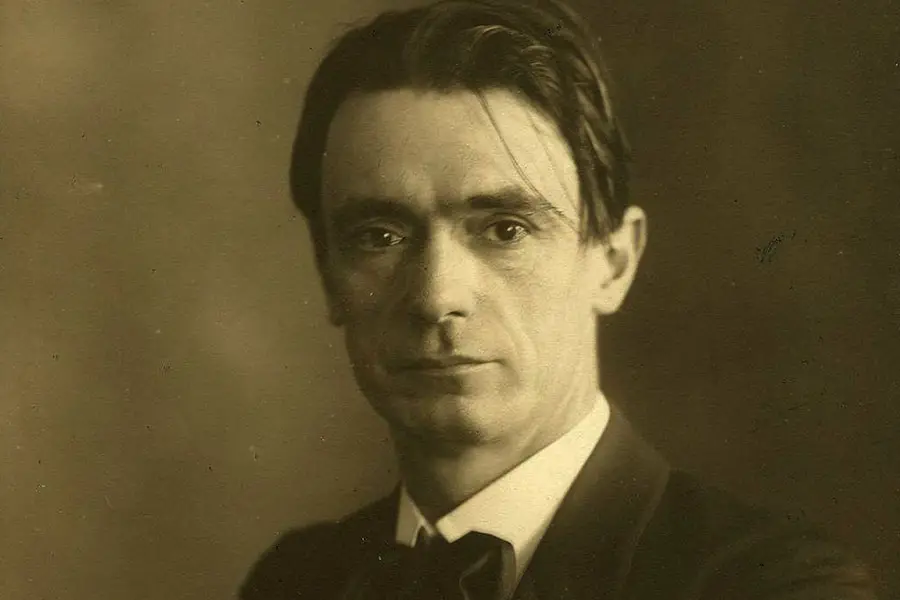Rudolf Steiner is an important name in the history of esoteric philosophy, and is famous for many reasons.
Rudolf Steiner is famous because of his philosophical teachings, which blended science and spirituality, and covered agriculture, education, movement therapy, and much more. His ideas were captured in 30 published books, and in over 6000 lectures.

Here are 10 reasons why Rudolf Steiner is famous:
1: Steiner was a Prolific Writer and Philosopher
Rudolf Steiner wrote over 30 books during his lifetime, covering a wide range of subjects including philosophy, spirituality, education, agriculture, medicine, and the arts. Here are a few of his most well-known works:
“The Philosophy of Freedom” – This book outlines Steiner’s philosophy of spiritual freedom and autonomy, and it is considered one of his most important works.
“Theosophy: An Introduction to the Spiritual Processes in Human Life and in the Cosmos” – This book provides an overview of Steiner’s spiritual teachings, including his ideas about the evolution of consciousness, the nature of the human soul, and the nature of the spiritual world.
“An Outline of Esoteric Science” – This book provides an in-depth examination of Steiner’s ideas about the spiritual nature of the universe and the evolution of consciousness.
“The Education of the Child” – This book is a seminal work on Waldorf education, and it outlines Steiner’s ideas about child development and the role of education in fostering a child’s intellectual, emotional, and spiritual growth.
“The Soul’s Long Journey: How the Bible Reveals Reincarnation” – This book explores Steiner’s views on reincarnation and how they are reflected in the Bible.
“Agriculture: Spiritual Foundations for the Renewal of Agriculture” – This book is a guide to biodynamic agriculture, and it outlines Steiner’s ideas about the spiritual basis of farming and how to cultivate the land in a sustainable and holistic manner.
2: Steiner Delivered over 6000 lectures
Rudolf Steiner delivered lectures throughout his life, from the 1890s until his death in 1925. He gave lectures in many countries across Europe, including Austria, Germany, Switzerland, and England.
Steiner also gave lectures in other parts of the world, including the United States and South America. His lectures were often given at Anthroposophical Society meetings, Waldorf schools, and cultural events, and were widely attended by people from a variety of backgrounds, including educators, artists, scientists, and spiritual seekers.
His lectures covered the full range of his interests, including anthroposophy, education, science and spirituality, social reform, art and culture, agriculture, and the environment.
3: Steiner Created a Synthesis of Science and Spirituality called “Spiritual Science”
Spiritual science, as developed by Rudolf Steiner, is a holistic approach to understanding the world and the human experience. It combines scientific method with spiritual insight and aims to provide a comprehensive view of the interconnectedness of the physical, spiritual, and social realms.
Steiner believed that conventional science, with its focus on material phenomena, was limited in its ability to fully understand the complexities of human existence, and that a spiritual-scientific approach was needed to fill in the gaps. In his view, spiritual science provides a means of accessing deeper knowledge and understanding of the world and the human soul, and it provides a framework for exploring the relationships between physical reality and spiritual reality.
Steiner’s approach to spiritual science covers a wide range of topics, including anthropology, cosmology, and spiritual evolution. He believed that the development of spiritual science could help individuals to better understand their own spiritual nature, and to develop a deeper sense of self and connection to the world.
In his work, Steiner often drew on spiritual traditions and mystical practices from a variety of cultures, as well as on his own direct experiences of the spiritual world, to support his insights and findings.
Overall, spiritual science as developed by Rudolf Steiner is a comprehensive, interdisciplinary approach to understanding the world and human existence, which seeks to integrate scientific and spiritual perspectives in a holistic manner.
4: Steiner Founded Anthroposophy
Anthroposophy is a philosophical and spiritual movement founded by Rudolf Steiner in the early 20th century. The term Anthroposophy is derived from the Greek words “anthropos,” meaning “human,” and “sophia,” meaning “wisdom.” Anthroposophy is concerned with the spiritual development of the individual, and it offers a path for personal growth and self-discovery. It views the human being as a unique and complex being, composed of physical, spiritual, and soul aspects, and it seeks to understand the interplay between these aspects.
Steiner founded the organization after being involved with anther organization, called the Theosophical Society, which had been founded in 1875 by Helena Blavatsky and Henry Steel Olcott. The Theosophical society was dedicated to the study of esoteric sciences, and was largely inspired by Blavatsky’s spiritual experiences in Tibet and India. You can read more about Blavatsky in Tibet here.
Steiner was invited to the speak at the Theosophical Society in after publishing an article about a fairy tale by German poet Johann Wolfgang von Goethe in 1899. This led to further meetings between him and the organization, and he eventually joined, becoming the head of a new section in Germany in 1902. Eventually tension grew between the two parties, as they began taking different directions. In particular, Steiner began focusing on Christianity, which Blavatsky did not care for.
In 1912 Steiner and the Theosophical Society parted ways, and he founded the new Anthroposophical Society. It started with around 3000 members and grew overtime, being led by an executive council, which Steiner advised and lectured.
5: Steiner Developed the Waldorf Education
Waldorf education is a holistic educational approach that Steiner developed. It is based on the principles of Anthroposophy, and it seeks to educate the whole child – physically, emotionally, intellectually, and spiritually.
Waldorf education emphasizes the importance of artistic and imaginative experiences, and it places a strong emphasis on developing the child’s creativity and sense of wonder. It also values a close relationship between the teacher and the student, and it seeks to foster a supportive, nurturing environment in the classroom.
Waldorf schools offer a curriculum that is broad and holistic, covering subjects such as language arts, mathematics, science, history, and the arts. The curriculum is structured to meet the developmental needs of the child at different stages of life, and it often includes practical work, such as gardening and manual arts, as well as more traditional academic subjects.
Waldorf education also places a strong emphasis on the development of social and ethical values, and it seeks to foster a sense of community and social responsibility in its students.
6: Steiner Developed Biodynamic Farming
Biodynamic farming is a method of farming Steiner developed, based on the principles of Anthroposophy. It seeks to cultivate the land in a holistic, sustainable manner.
Biodynamic farming views the farm as a self-contained, interconnected system, and it seeks to work with the natural rhythms and processes of the land to promote soil health and plant growth. It incorporates principles from organic farming, such as the use of compost and cover crops, and it also incorporates spiritual and esoteric practices, such as the use of cosmic rhythms and the preparation of special preparations made from plant and mineral materials.
Biodynamic farmers view their work as a spiritual practice, and they seek to work in harmony with the land, the plants, and the animals. They aim to create a farm ecosystem that is healthy, productive, and self-sustaining, and that maintains a balance between the physical, spiritual, and social aspects of farming.
Biodynamic farming practices include the use of cover crops, crop rotation, composting, and the application of biodynamic preparations. The use of these preparations is a key aspect of biodynamic farming, and they are designed to enhance the health and vitality of the soil, plants, and animals on the farm.
In addition to promoting sustainable agriculture, biodynamic farming also seeks to foster a connection between the farmer, the land, and the community. Many biodynamic farmers work together in networks and cooperatives, and they seek to promote a sense of community and social responsibility within their farming practices.
Overall, biodynamic farming is a holistic and sustainable approach to farming that views the farm as a self-contained system and seeks to cultivate the land in a way that is in harmony with the natural world and promotes health and vitality in the soil, plants, and animals.
7: Steiner Created the Goetheanum
Steiner was also a pioneering architect and designed a number of buildings, including the Goetheanum in Dornach, Switzerland, which serves as the headquarters of the Anthroposophical Society.
The Goetheanum is considered one of Steiner’s most important works and is considered a masterpiece of modern architecture. The building was originally constructed in 1913, and it was destroyed by fire in 1922. Steiner then designed a new building, which was completed in 1928, and it still stands today as a cultural and spiritual center. The design of the Goetheanum reflects Steiner’s ideas about the interconnectedness of the spiritual and physical worlds, and it is considered an expression of his vision for a more holistic and harmonious world.

8: Steiner Created Eurythmy, a form of Movement Therapy
Eurythmy is a form of movement and expression that was developed by Steiner, that is based on the idea that movement and gesture can be used to express spiritual and emotional experiences, and it seeks to bring the inner world of the soul into physical expression.
Eurythmy involves a wide range of movements, including walking, jumping, turning, and gesture, and it is performed to music, speech, and poetry. The goal of Eurythmy is to bring balance, harmony, and health to the performer, and to provide a visual representation of the inner spiritual experiences of the performer.
Eurythmy is often performed in schools, cultural centers, and theaters, and it is often used as a form of therapy to help people overcome physical, emotional, and spiritual challenges. It is also used as a form of expression in music, dance, and theater, and it is considered a way to bring the inner world of the soul into physical expression.
Overall, Eurythmy is a form of movement and expression that is based on the idea that gesture and movement can be used to express spiritual and emotional experiences, and it seeks to bring balance, harmony, and health to the performer. It is considered a unique form of art and therapy, and it is an expression of the ideas of Anthroposophy and Rudolf Steiner.
9: Steiner was an Advocate for Social Reform
His ideas have been influential in the development of various social movements, including the green movement and the new age movement.
Steiner advocated for holistic social reform that emphasised individual freedom, creativity, and spiritual development. He believed that by integrating spiritual principles into society, people could create a more harmonious and just world.
He believed in the importance of community living and advocated for architectural designs that fostered a sense of connection between individuals and the environment.
In Steiner’s view, social reform should be guided by a spiritual understanding of the world and the interconnectedness of all things, rather than solely by economic or political considerations.
10: Steiner was Attacked by Adolf Hitler
When the The National Socialist German Workers Party gained popularity in Germany after WW1, members of the group suggested that Steiner was contrary to their movement. Hitler accused Steiner of being a ‘tool of the Jews’, and nationalist extremists called for a ‘war against Steiner’.
Steiner made a series of lectures during this time that warned of the disasters that would follow if the National Socialists came to power. After repeated attempts at violence towards Steiner, he cancelled his speaking tour, and moved out of home in Berlin.
Anthroposophy, with its emphasis on spiritual freedom and individual development, was seen as a threat to the Nazi ideology, which promoted conformity and obedience to the state. As a result, Steiner’s books were banned and Waldorf schools were shut down by the Nazis. Some members of the Anthroposophical Society were also persecuted and imprisoned.

Despite these challenges, Steiner’s ideas and legacy continued to be maintained and passed down by his followers. In fact, the Waldorf schools continued to operate underground during the Nazi regime and emerged after the war to become a thriving international network of schools.
The attack by the Nazi regime helped to increase awareness of Steiner and his ideas, and cemented his reputation as a pioneering thinker and champion of spiritual freedom. Today, Waldorf education and Anthroposophy continue to be widely respected and studied, and Steiner’s work continues to inspire individuals and communities around the world.
Recommended Reading
If you want to continue exploring this subject more deeply, you can see which books I recommend by clicking here.
